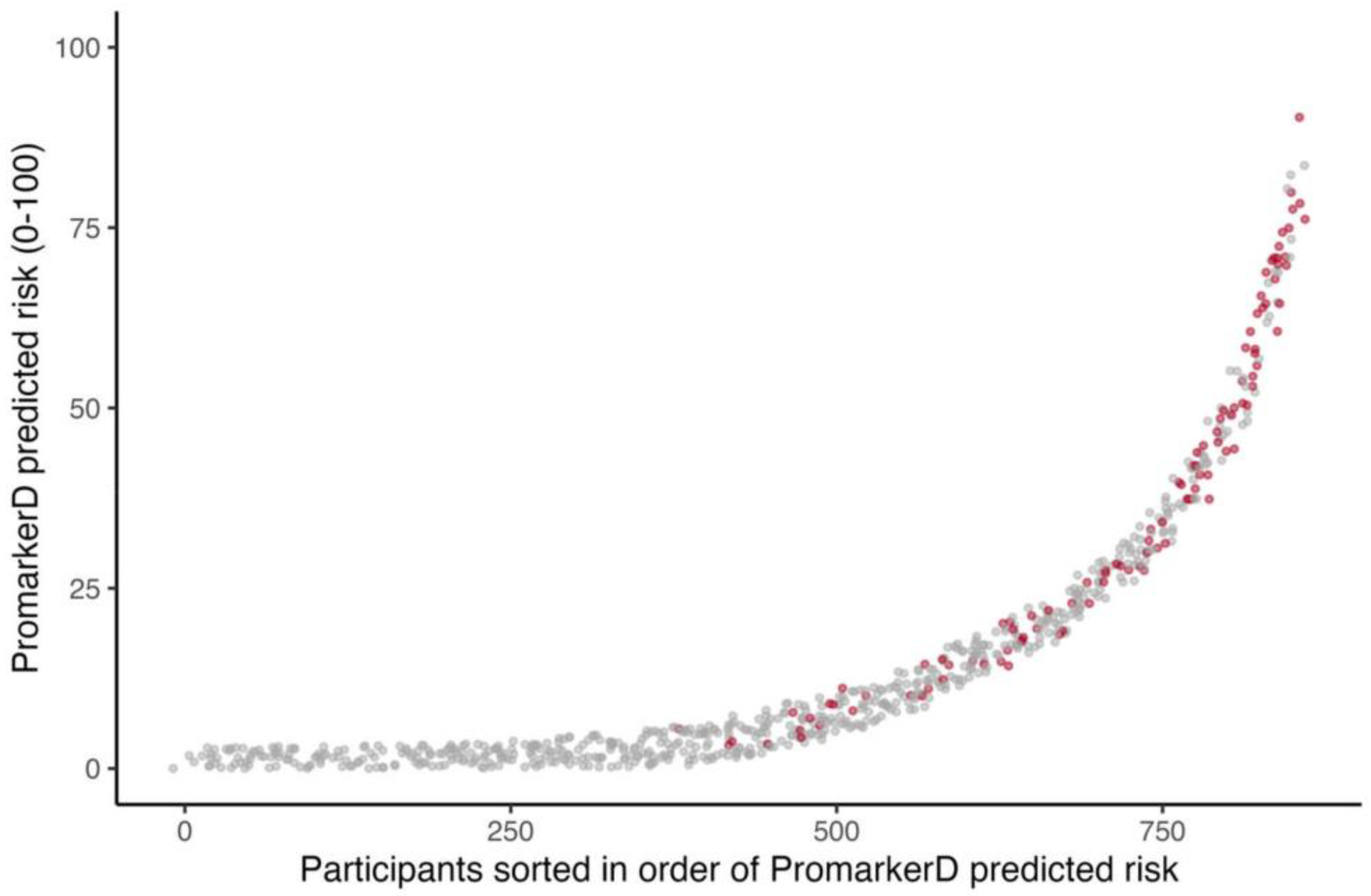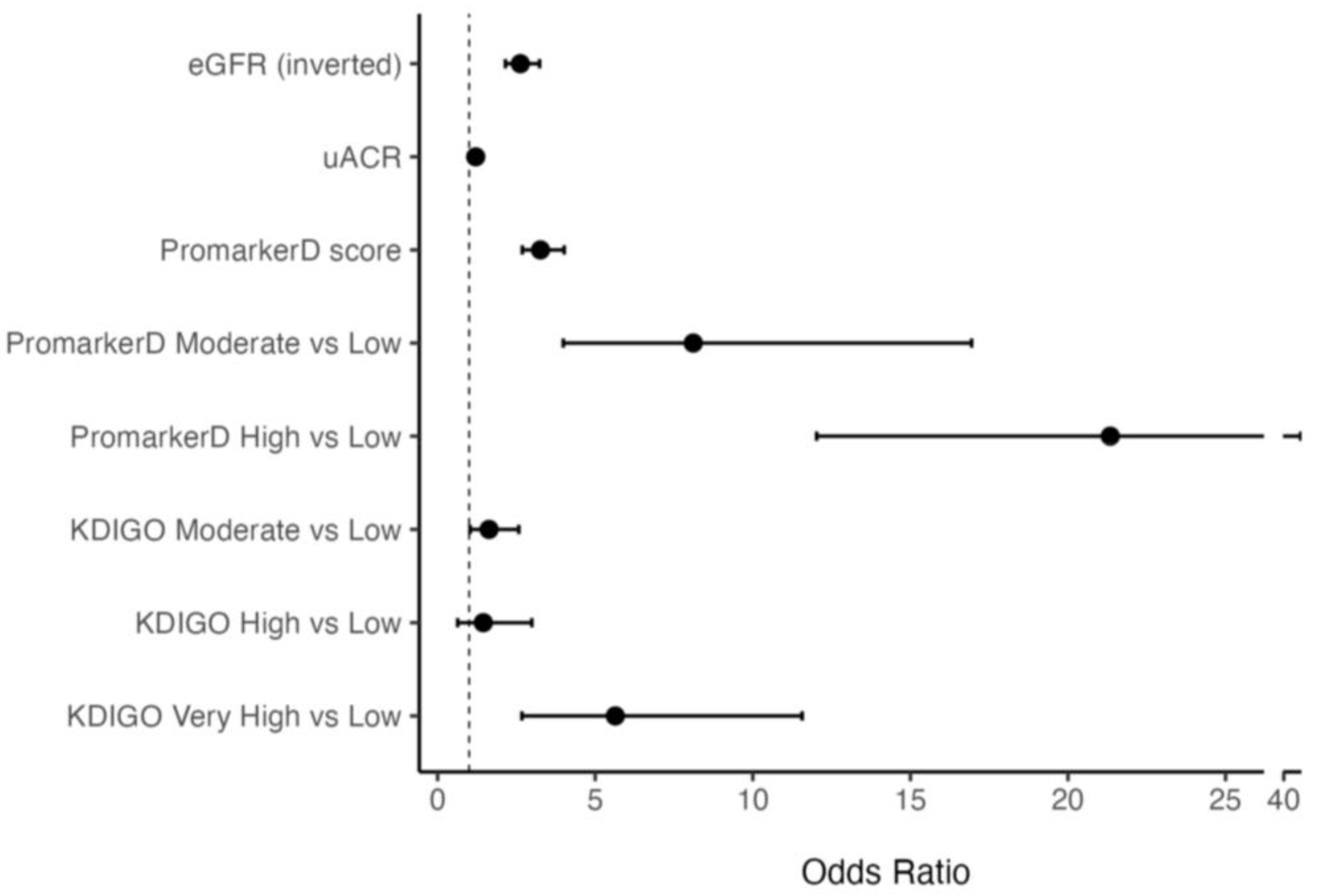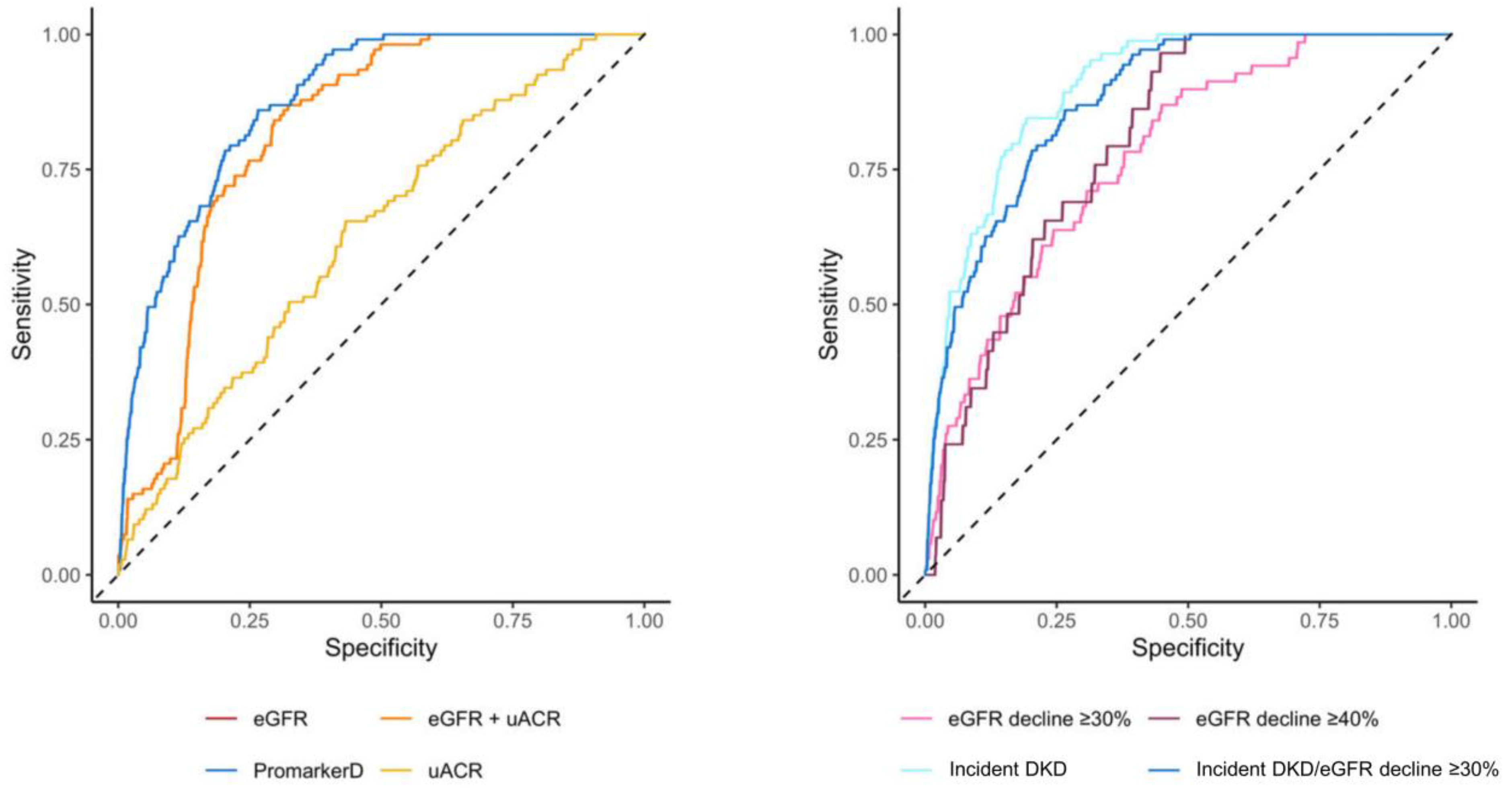PromarkerD Versus Standard of Care Biochemical Measures for Assessing Future Renal Function Decline in Type 2 Diabetes
Abstract
:1. Introduction
2. Materials and Methods
2.1. Participants
2.2. Clinical Assessment
2.3. Biomarker Quantification and Promarkerd Scoring
2.4. KDIGO Risk Stratification
2.5. Endpoint Ascertainment
2.6. Statistical Analyses
3. Results
3.1. Participant Characteristics
3.2. Renal Function Endpoints
3.3. Model Performance
3.4. PromarkerD in KDIGO Low-Risk Participants
3.5. Distribution of At-Risk KDIGO Participants
4. Discussion
5. Conclusions
Author Contributions
Funding
Institutional Review Board Statement
Informed Consent Statement
Data Availability Statement
Acknowledgments
Conflicts of Interest
Abbreviations
| DKD | Diabetic kidney disease |
| eGFR | Estimated glomerular filtration rate |
| uACR | Urinary albumin:creatinine ratio |
| T2D | Type 2 diabetes (T2D) |
| AUC | Area under the receiver operating characteristic curve |
| CI | Confidence interval |
| OR | Odds ratio |
| CKD | Chronic kidney disease |
| KDIGO | Kidney Disease Improving Global Outcomes |
| ApoA4 | Apolipoprotein A-IV |
| CDL5L | CD5 antigen-like protein |
| IGFBP3 | Insulin-like growth factor binding protein 3 |
| FDS2 | Fremantle Diabetes Study Phase II |
| Sn | Sensitivity |
| Sp | Specificity |
| PPV | Positive predictive value |
| NPV | Negative predictive value |
References
- Afkarian, M.; Zelnick, L.R.; Hall, Y.N.; Heagerty, P.J.; Tuttle, K.; Weiss, N.S.; de Boer, I.H. Clinical manifestations of kidney disease among US adults with diabetes, 1988–2014. JAMA 2016, 316, 602–610. [Google Scholar] [CrossRef]
- Farah, R.I.; Al-Sabbagh, M.Q.; Momani, M.S.; Albtoosh, A.; Arabiat, M.; Abdulraheem, A.M.; Aljabiri, H.; Abufaraj, M. Diabetic kidney disease in patients with type 2 diabetes mellitus: A cross-sectional study. BMC Nephrol. 2021, 22, 223. [Google Scholar] [CrossRef]
- Wan, K.S.; Hairi, N.N.; Mustapha, F.; Mohd Yusoff, M.F.; Mat Rifin, H.; Ismail, M.; Moy, F.M.; Ahmad, N.A. Prevalence of diabetic kidney disease and the associated factors among patients with type 2 diabetes in a multi-ethnic Asian country. Sci. Rep. 2024, 14, 7074. [Google Scholar] [CrossRef]
- Hoogeveen, E.K. The epidemiology of diabetic kidney disease. Kidney Dial. 2022, 2, 433–442. [Google Scholar] [CrossRef]
- Goncalves, G.M.R.; Silva, E.N.d. Cost of chronic kidney disease attributable to diabetes from the perspective of the Brazilian Unified Health System. PLoS ONE 2018, 13, e0203992. [Google Scholar] [CrossRef] [PubMed]
- McQueen, R.B.; Farahbakhshian, S.; Bell, K.F.; Nair, K.V.; Saseen, J.J. Economic burden of comorbid chronic kidney disease and diabetes. J. Med. Econ. 2017, 20, 585–591. [Google Scholar] [CrossRef] [PubMed]
- Chung, H.; Crowe, C.L.; Kong, S.X.; Singh, R.; Farej, R.; Elliott, J.; Williamson, T.; Willey, V.J. Descriptive study of the economic burden among patients with type 2 diabetes mellitus, chronic kidney disease, and chronic kidney disease and type 2 diabetes mellitus in a large US commercially insured population. J. Manag. Care Spec. Pharm. 2023, 29, 80–89. [Google Scholar] [CrossRef]
- Usó-Talamantes, R.; González-de-Julián, S.; Díaz-Carnicero, J.; Saurí-Ferrer, I.; Trillo-Mata, J.L.; Carrasco-Pérez, M.; Navarro-Pérez, J.; Górriz, J.L.; Vivas-Consuelo, D.; Redón, J. Cost of type 2 diabetes patients with chronic kidney disease based on real-world data: An observational population-based study in Spain. Int. J. Environ. Res. Public Health 2021, 18, 9853. [Google Scholar] [CrossRef] [PubMed]
- Xie, D.; Ma, T.; Cui, H.; Li, J.; Zhang, A.; Sheng, Z.; Xie, Y. Global burden and influencing factors of chronic kidney disease due to type 2 diabetes in adults aged 20–59 years, 1990–2019. Sci. Rep. 2023, 13, 20234. [Google Scholar] [CrossRef]
- Perkovic, V.; Jardine, M.J.; Neal, B.; Bompoint, S.; Heerspink, H.J.L.; Charytan, D.M.; Edwards, R.; Agarwal, R.; Bakris, G.; Bull, S.; et al. Canagliflozin and renal outcomes in type 2 diabetes and nephropathy. N. Engl. J. Med. 2019, 380, 2295–2306. [Google Scholar] [CrossRef]
- de Boer, I.H.; Khunti, K.; Sadusky, T.; Tuttle, K.R.; Neumiller, J.J.; Rhee, C.M.; Rosas, S.E.; Rossing, P.; Bakris, G. Diabetes management in chronic kidney disease: A consensus report by the American Diabetes Association (ADA) and Kidney Disease: Improving Global Outcomes (KDIGO). Diabetes Care 2022, 45, 3075–3090. [Google Scholar] [CrossRef] [PubMed]
- Yamazaki, T.; Mimura, I.; Tanaka, T.; Nangaku, M. Treatment of diabetic kidney disease: Current and future. Diabetes Metab. J. 2021, 45, 11–26. [Google Scholar] [CrossRef] [PubMed]
- Handelsman, Y.; Butler, J.; Bakris, G.L.; DeFronzo, R.A.; Fonarow, G.C.; Green, J.B.; Grunberger, G.; Januzzi, J.L.; Klein, S.; Kushner, P.R.; et al. Early intervention and intensive management of patients with diabetes, cardiorenal, and metabolic diseases. J. Diabetes Its Complicat. 2023, 37, 108389. [Google Scholar] [CrossRef]
- Zanchi, A.; Jehle, A.W.; Lamine, F.; Vogt, B.; Czerlau, C.; Bilz, S.; Seeger, H.; de Seigneux, S. Diabetic kidney disease in type 2 diabetes: A consensus statement from the Swiss Societies of Diabetes and Nephrology. Swiss Med. Wkly. 2023, 153, 40004. [Google Scholar] [CrossRef]
- Kidney Disease: Improving Global Outcomes (KDIGO) CKD Work Group. KDIGO 2024 Clinical practice guideline for the evaluation and management of chronic kidney disease. Kidney Int. 2024, 105, S117–S314. [Google Scholar] [CrossRef]
- Alaini, A.; Malhotra, D.; Rondon-Berrios, H.; Argyropoulos, C.P.; Khitan, Z.J.; Raj, D.S.C.; Rohrscheib, M.; Shapiro, J.I.; Tzamaloukas, A.H. Establishing the presence or absence of chronic kidney disease: Uses and limitations of formulas estimating the glomerular filtration rate. World J. Methodol. 2017, 7, 73–92. [Google Scholar] [CrossRef]
- Tabaei, B.P.; Al-Kassab, A.S.; Ilag, L.L.; Zawacki, C.M.; Herman, W.H. Does microalbuminuria predict diabetic nephropathy? Diabetes Care 2001, 24, 1560–1566. [Google Scholar] [CrossRef] [PubMed]
- Jardine, M.J.; Hata, J.; Woodward, M.; Perkovic, V.; Ninomiya, T.; Arima, H.; Zoungas, S.; Cass, A.; Patel, A.; Marre, M.; et al. Prediction of kidney-related outcomes in patients with type 2 diabetes. Am. J. Kidney Dis. 2012, 60, 770–778. [Google Scholar] [CrossRef]
- Dunkler, D.; Gao, P.; Lee, S.F.; Heinze, G.; Clase, C.M.; Tobe, S.; Teo, K.K.; Gerstein, H.; Mann, J.F.E.; Oberbauer, R.; et al. Risk Prediction for Early CKD in Type 2 Diabetes. Clin. J. Am. Soc. Nephrol. 2015, 10, 1371–1379. [Google Scholar] [CrossRef]
- Peters, K.E.; Davis, W.A.; Ito, J.; Winfield, K.; Stoll, T.; Bringans, S.D.; Lipscombe, R.J.; Davis, T.M.E. Identification of Novel Circulating Biomarkers Predicting Rapid Decline in Renal Function in Type 2 Diabetes: The Fremantle Diabetes Study Phase II. Diabetes Care 2017, 40, 1548–1555. [Google Scholar] [CrossRef]
- Peters, K.E.; Davis, W.A.; Ito, J.; Bringans, S.D.; Lipscombe, R.J.; Davis, T.M.E. Validation of a protein biomarker test for predicting renal decline in type 2 diabetes: The Fremantle Diabetes Study Phase II. J. Diabetes Its Complicat. 2019, 33, 107406. [Google Scholar] [CrossRef]
- Lin, C.H.; Chang, Y.C.; Chuang, L.M. Early detection of diabetic kidney disease: Present limitations and future perspectives. World J. Diabetes 2016, 7, 290–301. [Google Scholar] [CrossRef] [PubMed]
- Colhoun, H.M.; Marcovecchio, M.L. Biomarkers of diabetic kidney disease. Diabetologia 2018, 61, 996–1011. [Google Scholar] [CrossRef] [PubMed]
- Davis, T.M.E.; Bruce, D.G.; Davis, W.A. Cohort profile: The Fremantle Diabetes Study. Int. J. Epidemiol. 2013, 42, 412–421. [Google Scholar] [CrossRef]
- Levey, A.S.; Stevens, L.A.; Schmid, C.H.; Zhang, Y.L.; Castro, A.F.; Feldman, H.I.; Kusek, J.W.; Eggers, P.; Van Lente, F.; Greene, T.; et al. A new equation to estimate glomerular filtration rate. Ann. Intern. Med. 2009, 150, 604–612. [Google Scholar] [CrossRef]
- Levey, A.S.; Inker, L.A.; Matsushita, K.; Greene, T.; Willis, K.; Lewis, E.; de Zeeuw, D.; Cheung, A.K.; Coresh, J. GFR decline as an end point for clinical trials in CKD: A scientific workshop sponsored by the National Kidney Foundation and the US Food and Drug Administration. Am. J. Kidney Dis. 2014, 64, 821–835. [Google Scholar] [CrossRef]
- Cherney, D.Z.I.; Dagogo-Jack, S.; McGuire, D.K.; Cosentino, F.; Pratley, R.; Shih, W.J.; Frederich, R.; Maldonado, M.; Liu, J.; Wang, S.; et al. Kidney outcomes using a sustained ≥40% decline in eGFR: A meta-analysis of SGLT2 inhibitor trials. Clin. Cardiol. 2021, 44, 1139. [Google Scholar] [CrossRef]
- DeLong, E.R.; DeLong, D.M.; Clarke-Pearson, D.L. Comparing the areas under two or more correlated receiver operating characteristic curves: A nonparametric approach. Biometrics 1988, 44, 837–845. [Google Scholar] [CrossRef]
- Youden, W.J. Index for rating diagnostic tests. Cancer 1950, 3, 32–35. [Google Scholar] [CrossRef]
- Fusfeld, L.; Murphy, J.T.; Yoon, Y.; Kam, L.Y.; Peters, K.E.; Lin Tan, P.; Shanik, M.; Turchin, A. Evaluation of the clinical utility of the PromarkerD in-vitro test in predicting diabetic kidney disease and rapid renal decline through a conjoint analysis. PLoS ONE 2022, 17, e0271740. [Google Scholar] [CrossRef]
- Datar, M.; Ramakrishnan, S.; Chong, J.; Montgomery, E.; Goss, T.F.; Coca, S.G.; Vassalotti, J.A. A kidney diagnostic’s impact on physician decision-making in diabetic kidney disease. Am. J. Manag. Care 2022, 28, 654–661. [Google Scholar] [CrossRef] [PubMed]
- Davis, T.M.; Chubb, S.A.; Davis, W.A. The relationship between estimated glomerular filtration rate trajectory and all-cause mortality in type 2 diabetes: The Fremantle Diabetes Study. Eur. J. Endocrinol. 2016, 175, 273–285. [Google Scholar] [CrossRef]
- American Diabetes Association Professional Practice Committee. 11. Chronic kidney disease and risk management: Standards of care in diabetes-2024. Diabetes Care 2024, 47, S219–S230. [Google Scholar] [CrossRef] [PubMed]
- Tang, W.H.; Hung, W.C.; Wang, C.P.; Wu, C.C.; Hsuan, C.F.; Yu, T.H.; Hsu, C.C.; Cheng, Y.A.; Chung, F.M.; Lee, Y.J.; et al. The lower limit of reference of urinary albumin/creatinine ratio and the risk of chronic kidney disease progression in patients with type 2 diabetes mellitus. Front. Endocrinol. Lausanne 2022, 13, 858267. [Google Scholar] [CrossRef]
- Moriconi, D.; Sacchetta, L.; Chiriaco, M.; Nesti, L.; Forotti, G.; Natali, A.; Solini, A.; Trico, D. glomerular hyperfiltration predicts kidney function decline and mortality in type 1 and type 2 diabetes: A 21-year longitudinal study. Diabetes Care 2023, 46, 845–853. [Google Scholar] [CrossRef]



| Age (years) | 65.4 ± 10.4 |
| Male sex (%) | 54.0 |
| Ethnic background (%): | |
| Anglo-Celt | 59.2 |
| Southern European | 11.1 |
| Other European | 7.9 |
| Asian | 4.5 |
| Aboriginal | 1.9 |
| Other | 15.4 |
| Age at diabetes diagnosis (years) | 56.1 ± 11.2 |
| Diabetes duration (years) | 7.4 [2.0–15.0] |
| Body mass index (kg/m2) | 31.4 ± 6.0 |
| Fasting serum glucose (mmol/L) | 7.4 (5.6–9.8) |
| HbA1c (%) | 7.1 ± 1.3 |
| HbA1c (mmol/mol) | 54 ± 12 |
| eGFR (mL/min/1.73 m2) | 81.7 ± 18.6 |
| eGFR categories (%): | |
| ≥90 mL/min/1.73 m2 | 39.7 |
| 60–89 mL/min/1.73 m2 | 47.8 |
| 45–59 mL/min/1.73 m2 | 7.5 |
| 30–44 mL/min/1.73 m2 | 3.9 |
| 15–30 mL/min/1.73 m2 | 0.8 |
| <15 mL/min/1.73 m2 | 0.2 |
| Urinary ACR (mg/mmol) | 2.2 (1.2–5.7) |
| Urinary ACR categories (%): | |
| <3 mg/mmol | 60.8 |
| 3–30 mg/mmol | 34.2 |
| >30 mg/mmol | 5.0 |
| Serum total cholesterol (mmol/L) | 4.3 ± 1.0 |
| Serum HDL cholesterol (mmol/L) | 1.24 ± 0.32 |
| Plasma biomarkers (at peak ratio) | |
| ApoA4 | 1.1 (0.5–2.1) |
| CD5L | 1.6 (0.7–3.4) |
| IGFBP3 | 1.0 (0.6–1.7) |
| Number (%) in Risk Category | Number (%) That Reached Primary Endpoint | p-Value | |||
|---|---|---|---|---|---|
| Total Cohort | 857 | 100 | 107 | 12.5 | |
| PromarkerD risk categories: | |||||
| Low | 542 | 63.2 | 14 | 2.6 | Ref |
| Moderate | 113 | 13.2 | 20 | 17.7 | <0.001 |
| High | 202 | 23.6 | 73 | 36.1 | <0.001 |
| KDIGO risk categories: | |||||
| Low | 480 | 56.0 | 45 | 9.4 | Ref |
| Moderate | 270 | 31.5 | 39 | 14.4 | 0.046 |
| High | 69 | 8.1 | 9 | 13.0 | 0.458 |
| Very high | 38 | 4.4 | 14 | 36.8 | <0.001 |
| Sn (%) | Sp (%) | PPV (%) | NPV (%) | AUC (95% CI) | ∆AUC | p-Value ‡ | |
|---|---|---|---|---|---|---|---|
| PromarkerD † | 86.0 | 73.5 | 31.6 | 97.3 | 0.88 (0.85–0.91) | Ref | |
| Moderate risk | 86.1 | 70.0 | 29.2 | 97.2 | |||
| High risk | 71.3 | 82.5 | 37.0 | 95.2 | |||
| eGFR † | 86.9 | 67.7 | 27.8 | 97.3 | 0.82 (0.79–0.85) | −0.057 | <0.001 |
| uACR † | 65.4 | 56.8 | 17.8 | 92.0 | 0.63 (0.57–0.68) | −0.249 | <0.001 |
| eGFR + uACR † | 86.9 | 67.7 | 27.8 | 97.3 | 0.82 (0.79–0.85) | −0.057 | <0.001 |
| Total | No Outcome | % | Outcome † | % | |
|---|---|---|---|---|---|
| KDIGO risk category | |||||
| Low risk | 480 | 435 | 91 | 45 | 9 |
| PromarkerD classification in this subgroup | |||||
| Low risk | 349 | 342 | 98 | 7 | 2 |
| Moderate risk | 46 | 38 | 83 | 8 | 17 |
| High risk | 85 | 55 | 65 | 30 | 35 |
| Total | 480 | 452 | 45 |
| Total | No Outcome | % | Outcome † | % | |
|---|---|---|---|---|---|
| KDIGO risk category | |||||
| Moderate risk | 270 | 231 | 86 | 39 | 14 |
| High risk | 69 | 60 | 87 | 9 | 13 |
| Very high risk | 38 | 24 | 63 | 14 | 37 |
| PromarkerD classification in this subgroup | |||||
| Low risk | 193 | 186 | 96 | 7 | 4 |
| Moderate risk | 67 | 55 | 82 | 12 | 18 |
| High risk | 117 | 74 | 63 | 43 | 37 |
| Total | 377 | 315 | 62 |
Disclaimer/Publisher’s Note: The statements, opinions and data contained in all publications are solely those of the individual author(s) and contributor(s) and not of MDPI and/or the editor(s). MDPI and/or the editor(s) disclaim responsibility for any injury to people or property resulting from any ideas, methods, instructions or products referred to in the content. |
© 2025 by the authors. Licensee MDPI, Basel, Switzerland. This article is an open access article distributed under the terms and conditions of the Creative Commons Attribution (CC BY) license (https://creativecommons.org/licenses/by/4.0/).
Share and Cite
Peters, K.E.; Joubert, I.A.; Bringans, S.D.; Davis, W.A.; Lipscombe, R.J.; Davis, T.M.E. PromarkerD Versus Standard of Care Biochemical Measures for Assessing Future Renal Function Decline in Type 2 Diabetes. Diagnostics 2025, 15, 662. https://doi.org/10.3390/diagnostics15060662
Peters KE, Joubert IA, Bringans SD, Davis WA, Lipscombe RJ, Davis TME. PromarkerD Versus Standard of Care Biochemical Measures for Assessing Future Renal Function Decline in Type 2 Diabetes. Diagnostics. 2025; 15(6):662. https://doi.org/10.3390/diagnostics15060662
Chicago/Turabian StylePeters, Kirsten E., Isabella A. Joubert, Scott D. Bringans, Wendy A. Davis, Richard J. Lipscombe, and Timothy M. E. Davis. 2025. "PromarkerD Versus Standard of Care Biochemical Measures for Assessing Future Renal Function Decline in Type 2 Diabetes" Diagnostics 15, no. 6: 662. https://doi.org/10.3390/diagnostics15060662
APA StylePeters, K. E., Joubert, I. A., Bringans, S. D., Davis, W. A., Lipscombe, R. J., & Davis, T. M. E. (2025). PromarkerD Versus Standard of Care Biochemical Measures for Assessing Future Renal Function Decline in Type 2 Diabetes. Diagnostics, 15(6), 662. https://doi.org/10.3390/diagnostics15060662








